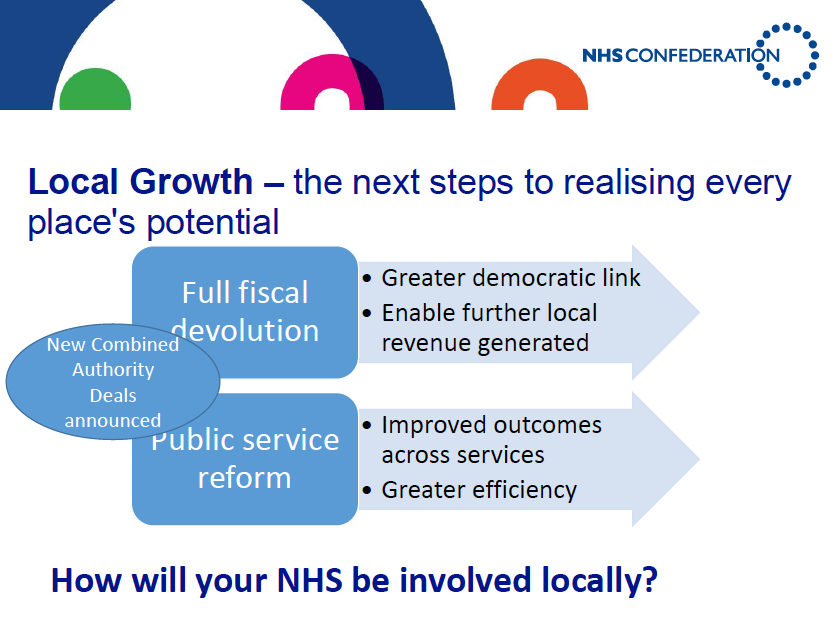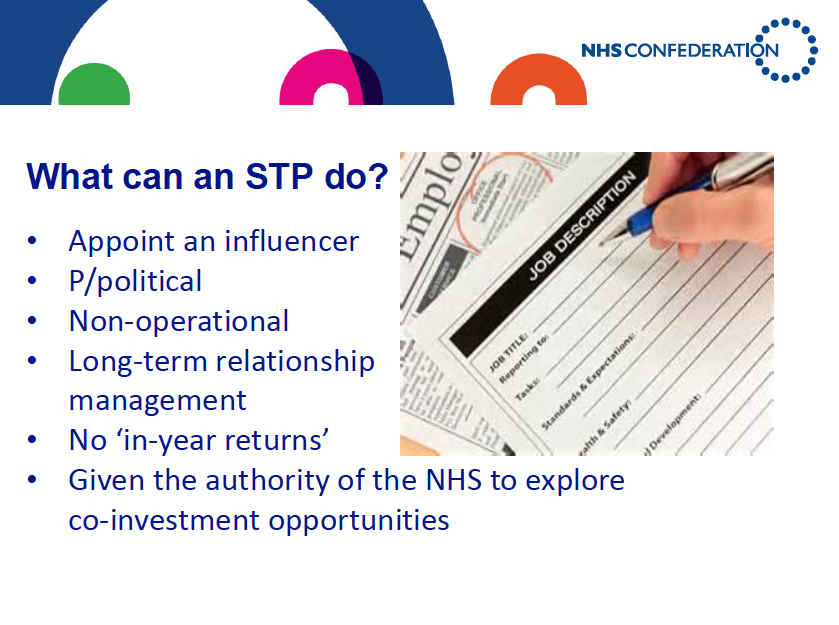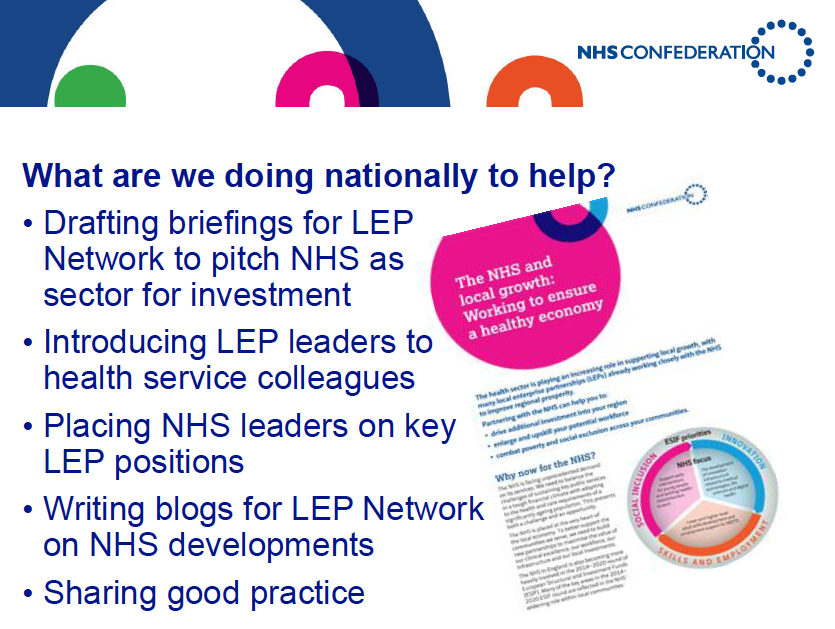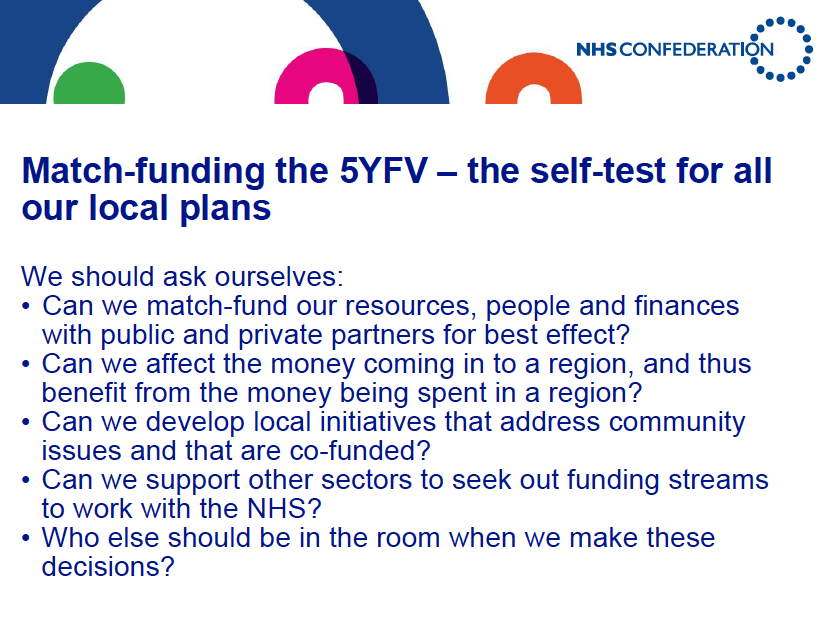Digitech is central to NHS Sustainability and Transformation Plans, says ex-Cerner Vice President turned NHS England Director.
What fresh revolving door horror is this?
Before he started his job at NHS England – pushing digitech as key to Sustainability and Transformation Plans – Matthew Swindells was Senior Vice President at the US health digitech company Cerner.
Cerner describes itself as:
“continuously building on our foundation of intelligent solutions for the health care industry”and “innovat[ing] at the intersection of health care and information technology.”
To anyone worried about the possibilities for corruption opened up by the revolving door between Cerner and NHS England, NHS England said:
“Swindells will divest himself of any financial interests in his former employer, and recuse himself from any official dealings with them for the subsequent 12 months after taking up post.”
But in the hollowed-out state, where global corporations effectively dictate government policy, Swindells’ personal financial and working relationship with his former employer is really neither here nor there.
This is how it works.
Cerner is a dominant supplier of electronic patient record systems to NHS hospitals; Matthew Swindells, who took up his post as NHS England’s National Director for Commissioning Operations and Information in May this year, wasted no time in proclaiming that digital technology
“must be embedded in Sustainability and Transformation Plans”.
At the same time, NHS England has just handed out £100 million of “digital excellence award” funding to acute hospital trusts, many them using Cerner digitech systems.
This “digital excellence” funding is to pay 12 acute hospital trusts to buy or develop digitech systems that will work on patients’ smartphones or handheld devices, so that they can get medical advice and info without seeing their doctors or other NHS staff.
This is in line with the new model of care known as “care closer to home” that NHS England is pushing through Sustainability and Transformation Plans (STP). It is also the line of work – called “population health” in Cerner corporate-speak – that Matthew Swindells was involved in at Cerner.
To deliver this new STP care model, Accountable Care Organisations (ACOs) are to replace Clinical Commissioning Groups and the existing contracting system. An Accountable Care Organisation is a form of public/private partnership that is designed to restrict “managed” care to the patients who will be cheapest to treat, and relies on patients’ use of digitech to self-monitor their bodily functions in order to avoid costly face to face care.
This is all designed to to generate “efficiencies” – ie profits – for the ACO.
The Kings Fund is currently pushing the South Central Alaska model of ACO; Matt Walsh, Calderdale CCG’s Chief Officer told the August 2016 Calderdale Health and Wellbeing Board meeting that he favoured this model for the Calderdale “locality” STP.
Matthew Swindells’ former employer Cerner is behind the Kings Fund promotion of the South Central Alaska ACO model: the company commissioned the Kings Fund to write a report on how the NHS can redisorganise itself to fit with Cerner’s digitech-driven model of delivering privatised health care, via personal health budgets and the Care Closer to Home clinical model.
“New technologies will provide the framework for new models, and new models will drive the need for new and innovative technology.” Gartner Industry Research – Agenda Overview for Healthcare, 2013
If you’d like more details, please read on.
Former Cerner Vice President in co-driver’s seat for secretive roll out of Sustainability and Transformation Plans
NHS England appointed Matthew Swindells in December 2105, just in time for the Sustainability and Transformation Plans roll out. Now he is in a co-driver’s seat for the Sustainability and Transformation Plans, where he directs regional teams in their commissioning responsibilities.
He must therefore be held responsible for the secrecy that regional teams have imposed on the development of STPs; as NHS England’s North Midlands Director of Commissioning Operations, Wendy Saviour, told a recent meeting of Shropshire Clinical Commissioning Group:
“STPs are not meant to be published at all. They should not go to Board meetings. Some of them contain very radical things… These are highly political and highly contentious. Once they’re washed off and the national messages are gathered together, they will be published.”
At the recent NHS Expo earlier this month, Matthew Swindells reinforced this. He said that NHS England would “discourage” people from publishing STPs they’re working on.
STPs are about fragmenting the NHS – not joining it up
Everyone – including Simon Stevens, the former President of global American health insurance company United Health and now Chief Exec of NHS England – is banging on about how Sustainability and Transformation Plans are about integrating NHS and social care services. But when you look at the STPs’ health digitech drive, this claim looks like smoke and mirrors.
The real aim of the STPs is to complete the job of fragmenting the NHS that the New Labour government began in 2000 with the Concordat that opened up the NHS to private health companies, and that later accelerated as a result of the Con/Dem Health and Social Care Act 2012.
The 26 hospital Trusts that NHS England invited to apply for the digital excellence funding have been at the forefront of computerised health information systems that originated in and were designed for the fragmented US health care market.
The function of these computerised systems is to support a marketised, revenue-generating healthcare system and a broader political ethos / ideology of consumerism that replaces ideas of citizenship.
“…the market drive of consumerism must pave the information infrastructure for healthcare applications” Steen and Detmer DE (1991,7) p4 (pdf)
In the USA, one of the drivers behind investment in computerised health information systems which was an easy political win (a vision to persuade people), is that their private healthcare system was and is still fragmented and complex with a discontinuity of care, multipayers, multiproviders, inefficient and constantly more expensive.
But there is evidence that digitech doesn’t solve these problems.
As the American private health care system is vastly expensive (unlike the efficient and effective public NHS) – so the drive to cut costs is central. The whole model of medicine that Stevens and Swindells have set out to impose on the NHS is designed to solve problems that did not exist here, until – as Special Advisors to the Blair government – they set out to create them by importing the US system into the NHS.
Despite all the claims about Sustainability and Transformation Plans being about “joined up care”, their real aim is to recreate the fragmented and complex American private healthcare system.
Sustainability and Transformation Plans – turning the NHS into a private/public “health sector” to drive local economic growth plans and “match fund” the Five Year Forward View
The plan is that this will occur through increased privatisation and public/private partnerships between a vast range of NHS commissioners and providers, private health companies, voluntary and community sector organisations – and a range of other companies, as health and social care services are harnessed to Local Economic Partnerships as a vehicle of economic growth and a way of securing “external investment” in the NHS through “a host of new finance mechanisms”.
According to the NHS Confederation, which describes itself as a network of NHS “partners” – ie private companies angling for NHS money, the aim is to “match fund” the 5 Year Forward View. That means bringing in over £100bn/year of private finance into the NHS for five years.
Abandon old-style contracting. Impose Cerner – friendly contracting
So it is really no surprise that Matthew Swindells recently told CCGs to abandon “old style” contracting.
The Sustainability and Transformation Plans will replace the “old style” contracting with Accountable Care Organisations (ACOs).
ACOs are a form of public private partnership – think PFI, but for NHS services as well as buildings. As already mentioned, the hot favourite ACO model – plugged by the Kings Fund – is South Central Alaska.
Cerner is behind the Kings Fund’s promotion of the South Central Alaska model of Accountable Care Organisation as the new Sustainability and Transformation Plan form of contracting.
The Kings Fund report that plugs the South Central Alaska ACO was commissioned by Cerner, with the brief to:
“write a report analysing how an intentional whole health system redesign can deliver better health outcomes to a population. The report, based on independent research conducted by The King’s Fund, focuses on Southcentral Foundation.”
The King’s Fund are now promoting Cerner’s goal of “intentional whole health system redesign” through a health system redisorganisation “masterclass” on 12 October.
Why not ask your CCG if any of their staff are attending?
Nearly half of Sustainability and Transformation Plan “Centres of digital excellence” awards go to Trusts with Cerner IT systems
At the end of August 2016, NHS England was about to recommend awarding the majority of the £100 million ‘centres of digital excellence’ funds to trusts that run Cerner systems. Frantic lobbying then took place to include more Trusts running other systems, with one “senior source” from among NHS IT leaders and suppliers reported as protesting,
“Centrally picking one supplier, with a handful of others thrown in for window dressing, is repeating the worst mistakes of the National Programme for IT.”
In the event, of the 12 Centres of Digital excellence awards, at least 5 have gone to Trusts using Cerner IT systems. Announcing the awards, Secretary of State for Health Jeremy Hunt said each Trust would “buddy up” with a leading US hospital such as the Cleveland or Mayo clinics.
The Cleveland Clinic has just submitted an application to open a 205 bed private planned care hospital in London.
The centres of digital excellence scheme follows a review of NHS technology conducted by an American doctor, Robert Wachter, who is the founder and academic leader of the hospitalist specialty in medicine.
I can’t really get my head round the jargon, but it seems that a hospitalist is a generalist type of hospital doctor who chases up all the treatments for their patients and liaises with their GPs. It looks as if it could be part of the new modern workforce that NHS England bangs on about in the 5 Year Forward View, to deliver the care closer to home care model via either the Multispeciality Community Provider schemes or the Primary and Acute Care Systems schemes.
“Digital excellence centres” promote patients’ use of smartphones and mobile devices
The hospital Trusts that are centres of digital excellence will set up digital technology so that patients can access more services via smartphones and mobile devices.
This ties in with the so-called Care Closer to Home scheme that copies the model for “demand management” – ie restricting treatments and access to services – used by the American private health care company, Kaiser Permanente, and others.
It requires patients with long term health problems to monitor their own symptoms at home using interactive digital technology that will send data about their bodily processes to specialist nurses and/or GPs.
The aim is to target care without relying on expensive personal contact between doctors/nurses and patients as a way of checking on patients’ health.
The system would also direct behaviour change incentives and messages to people statistically at risk of developing various illnesses. This aims to reduce the the likelihood that they will become ill.
But there’s little evidence that this actually works.
And it looks as if a lot of the much-vaunted increase in NHS funding via the Sustainability and Transformation Fund, is going straight into the pockets of digitech companies like Matthew Swindell’s former employer.
Here is what Cerner has to say about the kind of health digitech that the “digital excellence” fund is going to pay for:
“Cerner has several exciting projects and relationships related to some key aggregation platforms, including Apple and Validic, which are on the augmented self-management end of the remote monitoring spectrum, and Qualcomm Life, which is active monitoring. Cerner also has a relationship with Livongo to improve outcomes for diabetics. These relationships will increase the ability for Cerner clients to track their patients remotely, whether to manage chronic conditions through a prescribed device or kit, or through an ecosystem of apps enabling patients to manage their day-to-day health.”
The NHS England panel that chose which Trusts to award the centres of digital excellence funds to was appparently led by Professor Keith McNeil, NHS England’s first chief clinical information officer, who reports to Matthew Swindells.
At the NHS Expo – a business-sponsored event plugging the wonders of privatisation via personal health budgets and a bonanza for big pharma and big digitech – Matthew Swindells announced that digital technology must be embedded in Sustainability and Transformation Plans.
And Simon Stevens had previously announced at the NHS Confederation conference that,
“…from April next year, we will add a piece to the national tariff system specifically for new med tech innovations that have been shown to be cost-saving or help patients with supported self-management.”
Einstein’s definition of insanity – keep on doing the same thing and expect a different outcome
The “embedding” of digital technologies and companies in the NHS was started by the Blair New Labour government, where both Simon Stevens and Matthew Swindells worked as Special Advisors for Health Secretary Patricia Hewitt.
The National Health Service IT Programme originated in a secretive Downing Street meeting that Tony Blair held in 2002.
Known attenders included Microsoft and Cisco, although details of this meeting are very brief and were not released until a FOI in 2008. This begs the question – who else was present or liaising with the Department of Health (where former McKinsey staff had been installed as advisors by the New Labour Health Secretary)?
Update 30.6.2023 Thanks to Wikileaks, we now have a copy of Simon Stevens’ briefing to Tony Blair for an 18th Feb 2002 10 Downing Street Seminar on NHS IT
Here it is. The briefing informs the Prime Minister that SImon Stevens has also attached “optional reading from one of the leading US healthcare journals on the impact of information systens on healthcare delivery,” and has plenty more if Blair wants it.
Simon Stevens’ briefing shows that Cisco and Microsoft, as “the Department of Health’s private partners”, were to attend the Downing Street seminar.
Others who were to attend included Peter Gershon, previously the managing director of GEC Marconi and the chief operating officer of BAE systems, before 2000 when he moved to head the office of government commerce. In 2003, Gershon led a review of the public sector that identified more than £20bn of potential ‘savings’.
Also scheduled to attend the Downing Street Seminar on NHS IT was Andrew Pinder, who led the Office of the e-Envoy from 2000 to 2004, reporting directly to the Prime Minister. He was responsible for coordinating the development of the knowledge economy in the UK, and oversaw the rapid implementation in 2001 of the Government Gateway, a Microsoft-built project for putting all the government services online.
New Labour’s NHS Programme for IT (NHSPfIT) began without a remit to support patients and the working practices of NHS professionals, administrators; instead it was a techno-utopian woo vision of what technology could deliver, with a rushed schedule for realising it that predictably ended in tears. NHSPfIT did not achieve what Simon Stevens and others said it would do conceptually, and did not deliver the efficiencies they said it would, during the timescales that were set.
Simon Stevens disappeared off to head up United Health in 2004 (also the year that Microsoft ‘landed’ a 10 yr contract with the NHS and Accenture was also well under way with their lucrative NHS contract).
Is NHSPfiT mark 2 – aka the STP digital excellence scheme – going to do any better? And will it even matter to the revolving door merchants Simon Stevens and Matthew Swindells, who are pushing it? After all, as Stuart Player and Colin Leys wrote in 2010 :
“…the plan to turn the National Health Service into a healthcare market does not rest on rational arguments but material interests… the plans are not really new, but are the culmination of a decade-long campaign by the private health industry to get its hands on the NHS budget.”
And that is what the STPs are really about.
Swindells & Stevens: merchants of California techno woo
As Blair’s health adviser, before moving to United Health in 2004, Simon Stevens was instrumental in bringing in the NHSPfIT through private meetings (only partially revealed through a Computer Weekly FOI in 2008, as mentioned above). He is doing the same thing over again and no doubt will make some more money from it when he leaves what is left of the NHS.
Both Swindells and Stevens are merchants of California techno woo. This particular brand of snake oil is the biggest marketing con of the (new) age.
Health information systems apparently will deliver a $53 billion market globally in 2019 because of vaguely defined proposals for ‘integrated care’ and ‘care closer to home’. Good news for marketeers, bad news for patients and NHS staff.
The task of Save the NHS campaigners is to run these shysters out of town.
Update 30.9.2022 – Another spin through revolving door for Swindells
In July 2019 Swindells left NHS England, where his role had progressed to Director of Operations for the merged NHS England/NHS Improvement, to join the strategic advisory firm Global Counsel, co-founded and chaired by Peter Mandelson – a key cabinet member in Tony Blair’s New Labour government.
Global Counsel has US spy-tech data firm Palantir as a client, and since Covid-19 hit Palantir has been fishing to get control of huge new NHS data contracts. According to a report in The Register ,
“The [Global Counsel] association with Palantir was such that Chelsea and Westminster Hospital, the flagship Palantir user where Swindells is a chairman, said he would be excluded from ‘any decision making in relation to Palantir [PDF].’ “
Details are now emerging about how Palantir – the US spy-tech biz hotly tipped to win a new £360 million ($421 million) NHS data platform contract – has influenced the controversial procurement
In an apparent attempt to promote Palantir’s use in the NHS, not only has the company recently hired two key figures in NHS England’s data science and AI teams – Indra Joshi and Harjeet Dhaliwal; Palantir also appears to have hired Matthew Swindells by proxy, via his position working for consultancy Global Counsel, where Palantir is a client.
The Register reports that,
“NHSE&I did not begin work with Palantir until March 2020, during the early months of the pandemic. But questions about whether Swindells met with NHS or DHCS officials in his new consultancy role between September 2019 and the end of February 2020 are awaiting an official response.
“Nonetheless, influence among wider NHS leadership is perhaps the aim. In December 2021, Global Counsel and Palantir jointly hosted a webinar to consider the “next steps the UK should take in realising UK’s life sciences vision.”
“A Palantir white paper published in late 2021 also includes some similarities to the NHS data strategy, which emerged in June 2022. The Global Counsel webinar marked the formal release of Palantir’s white paper, titled A National Technical Framework to Underpin the UK Life Sciences Vision .
“Swindells chaired the webinar meeting. Also speaking were professor Martin Severs, former medical director at NHS Digital, and Dr Claire Bloomfield, then deputy director for value of data, Centre for Improving Data Collaboration, NHSX, the disbanded digital strategy unit under the DHSC. Bloomfield is now at NHS Transformation Directorate as senior responsible owner for data research and development.
“The Register understands from the NHS that officials take part in supplier events to ensure the health service is “part of the conversation” in the health tech industry.
“Published in December 2021, Palantir’s white paper [PDF] contains some striking similarities to the later NHS data strategy published six months later. It advocates for “a logically federated, locally controlled cloud-based data infrastructure,” which would “enable local data owners (care providers) to maintain control over their data, maximise the potential for research across the UK.”
“Meanwhile, the NHS data strategy (June 2022 – which you can read here) says: “We are looking to develop a federated data platform which will be a system of connected platforms, placed in, and ultimately determined by, individual NHS organizations.”
“FDP procurement documents shared with suppliers and seen by The Register said: “Local trusts and [integrated commissioning systems] will therefore have the autonomy to use the [federated] platform to address their own key challenges and priorities.”
“NHSI&E officials maintain it engaged with and was informed by a range of stakeholders including the wider health and care system, industry and academics. The federated approach was recommended by NHSE&I, they said.”






What these people are engaged in is adding worthless bells and whistles to health care. Monitoring my blood pressure 24 hours a day will have precious little health benefit for me. I doubt whether any GP will bother to look at it and certainly won’t have the time. With respect to national health and care of the ill you have summed up the value of Mr Swindells and his associates in one phrase: ” run these shysters out of town “
“I doubt whether any GP will bother to look at it and certainly won’t have the time.”
Well the beauty of it from Hunt’s point of view: he thinks that there will be no need for GPs to monitor the output of the self-monitoring technology. To do that, only some less qualified grade such as the “hospitalist” will be required who will be the gatekeeper to access to the GP and hospital treatment. It’s all about rationing and that’s why there will be fewer hospitals and GPs as a result. You won’t be allowed to access health care at all unless you satisfy the criteria built into the technology.